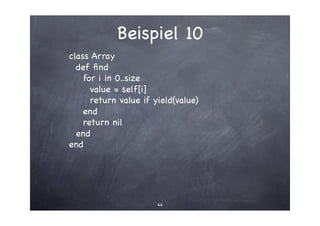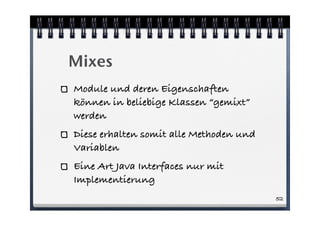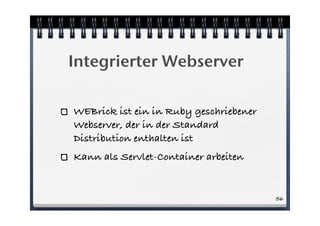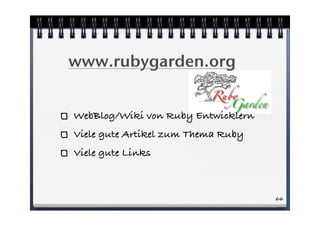An Introduction to Ruby
0 gefällt mir2,414 aufrufe
An Introduction to Ruby, the programming language by Jonathan Weiss. Presented at the Juniter Workend in 2005.
1 von 80
124-mal heruntergeladen
















































































Anzeige
Empfohlen
Battle of the Languages: Java und Python im Wettstreit beim Lösen von Program...



Battle of the Languages: Java und Python im Wettstreit beim Lösen von Program...gedoplan Vortrag von MIchael Inden auf dem Expertenkreis Java, GEDOPLAN GmbH
Bielefeld, 27.5.2021
Devs@Home - Einführung in Go



Devs@Home - Einführung in GoFrank Müller Deutschsprachige Einführung in Go im Rahmen der Devs@Home Webinare.
Perl - die Taschenkettensäge unter den Programmiersprachen - Vortrag 2003



Perl - die Taschenkettensäge unter den Programmiersprachen - Vortrag 2003Brigitte Jellinek Vorstellung der Programmiersprache Perl auf drei Ebenen: für Programmier-Anfänger, für Fortgechrittene und für Profis. inkl. Buchtipps zu Perl.
Ein Vortrag den ich ursprünglich am Chaos Communication Congress 2000 in Berlin gehalten habe, hier in der Version von 2003.
Perl 5 Quiz Chemnitz Edition



Perl 5 Quiz Chemnitz Editionlichtkind Extra brutales quiz, rund um Perl 5.16, Introspektion, und einige kaum beachtete Nischen von Perl 5
Perl 5.20: Feature, Kultur, Module, Werkzeuge



Perl 5.20: Feature, Kultur, Module, Werkzeugelichtkind der aktuelle Stand Perl 5.20 an features und Kultur: beeinflusst von Perl 6 wird an den wesentlichen Stellen aufgeräumt: dies war das Update für den Linuxtag in Chemnitz März 2015
Was geht mit Java 17?



Was geht mit Java 17?gedoplan Vortrag von Jens Seekamp auf dem Expertenkreis Java, GEDOPLAN GmbH, 20.1.2022
C Sharp Einfuehrung Teil 1



C Sharp Einfuehrung Teil 1DraphonyGames Folien vom C# Einführungskurs: Grundlagen der Programmierung
http://www.draphony.de/veranstaltungen/2013-winter/c-sharp-einfuehrung/
C Sharp Einfuehrung Teil 2



C Sharp Einfuehrung Teil 2DraphonyGames Folien vom C# Einführungskurs: Einführung in OOP
http://www.draphony.de/veranstaltungen/2013-winter/c-sharp-einfuehrung/
Die freie Programmiersprache Python 



Die freie Programmiersprache Python Andreas Schreiber Vortrag über Python und pyCologne auf dem Software Freedom Day 2010 (18. September 2010, Köln)
Spaß an der Nebenläufigkeit



Spaß an der NebenläufigkeitFrank Müller Talk zum Thema Nebenläufigkeit auf der OOP 2016 in München. Neben einer prinzipiellen Einführung und Motivation werden die Sprachen Erlang/OTP, Google Go und Pony vorgestellt. Weiter sind einige typische Designmuster sowie Fallstricke enthalten. Der Vortrag hatte die Dauer von 90 Minuten.
Ruby is Magic - Episode #7: Closures



Ruby is Magic - Episode #7: ClosuresDirk Breuer In dieser Ausgabe von 'Ruby is Magic' stellen wir euch Closures in Ruby einmal etwas genauer vor.
Funktionales Programmieren mit Clojure



Funktionales Programmieren mit ClojureDr. Christian Betz Überblick über die Entwicklung mit Clojure bei HEROLABS.
* Warum haben wir uns für Clojure entschieden? (Simplicity, Erweiterbarkeit, Java-Interop)
* Was heißt Funktionale Programmierung?
=> Man braucht ein anderes Mindset
* Was uns stört.
* Und wie entwickelt man mit Clojure (Ecosystem)?
Anlass war ein Talk bei mgm-tp.
C# Workshop - Threading



C# Workshop - ThreadingQiong Wu That's the slides for our C# Workshop at Darmstadt University of Technology, powered by Microsoft Student Partners.
An Introduction to Ruby On Rails



An Introduction to Ruby On RailsJonathan Weiss An Introduction to the Web framework Ruby on Rails by Jonathan Weiss. Presented for Juniter in 2005.
Anzeige
Weitere ähnliche Inhalte
Was ist angesagt? (20)
Perl 5 Quiz Chemnitz Edition



Perl 5 Quiz Chemnitz Editionlichtkind Extra brutales quiz, rund um Perl 5.16, Introspektion, und einige kaum beachtete Nischen von Perl 5
Perl 5.20: Feature, Kultur, Module, Werkzeuge



Perl 5.20: Feature, Kultur, Module, Werkzeugelichtkind der aktuelle Stand Perl 5.20 an features und Kultur: beeinflusst von Perl 6 wird an den wesentlichen Stellen aufgeräumt: dies war das Update für den Linuxtag in Chemnitz März 2015
Was geht mit Java 17?



Was geht mit Java 17?gedoplan Vortrag von Jens Seekamp auf dem Expertenkreis Java, GEDOPLAN GmbH, 20.1.2022
C Sharp Einfuehrung Teil 1



C Sharp Einfuehrung Teil 1DraphonyGames Folien vom C# Einführungskurs: Grundlagen der Programmierung
http://www.draphony.de/veranstaltungen/2013-winter/c-sharp-einfuehrung/
C Sharp Einfuehrung Teil 2



C Sharp Einfuehrung Teil 2DraphonyGames Folien vom C# Einführungskurs: Einführung in OOP
http://www.draphony.de/veranstaltungen/2013-winter/c-sharp-einfuehrung/
Die freie Programmiersprache Python 



Die freie Programmiersprache Python Andreas Schreiber Vortrag über Python und pyCologne auf dem Software Freedom Day 2010 (18. September 2010, Köln)
Spaß an der Nebenläufigkeit



Spaß an der NebenläufigkeitFrank Müller Talk zum Thema Nebenläufigkeit auf der OOP 2016 in München. Neben einer prinzipiellen Einführung und Motivation werden die Sprachen Erlang/OTP, Google Go und Pony vorgestellt. Weiter sind einige typische Designmuster sowie Fallstricke enthalten. Der Vortrag hatte die Dauer von 90 Minuten.
Ruby is Magic - Episode #7: Closures



Ruby is Magic - Episode #7: ClosuresDirk Breuer In dieser Ausgabe von 'Ruby is Magic' stellen wir euch Closures in Ruby einmal etwas genauer vor.
Funktionales Programmieren mit Clojure



Funktionales Programmieren mit ClojureDr. Christian Betz Überblick über die Entwicklung mit Clojure bei HEROLABS.
* Warum haben wir uns für Clojure entschieden? (Simplicity, Erweiterbarkeit, Java-Interop)
* Was heißt Funktionale Programmierung?
=> Man braucht ein anderes Mindset
* Was uns stört.
* Und wie entwickelt man mit Clojure (Ecosystem)?
Anlass war ein Talk bei mgm-tp.
C# Workshop - Threading



C# Workshop - ThreadingQiong Wu That's the slides for our C# Workshop at Darmstadt University of Technology, powered by Microsoft Student Partners.
Ähnlich wie An Introduction to Ruby (20)
An Introduction to Ruby On Rails



An Introduction to Ruby On RailsJonathan Weiss An Introduction to the Web framework Ruby on Rails by Jonathan Weiss. Presented for Juniter in 2005.
The Lotus Code Cookbook



The Lotus Code CookbookUlrich Krause The Lotus Code Cookbook - Ulrich Krause
Tipps, Tipps, Tipps ... Die Session behandelt kein zentrales Thema. In loser Folge werden Tipps und Tricks aus allen Bereichen der Programmierung in Lotus Notes / Domino vorgestellt. @Formula, LotusScript, Java, JavaScript, LS2CApi.
Zielgruppe sind Alle, die sich mit Applikationsentwicklung beschäftigen. Anfänger und "alte Hasen"; es ist für jeden etwas dabei.
Einführung in die funktionale Programmierung mit Clojure



Einführung in die funktionale Programmierung mit ClojureSascha Koch Diese Präsentation ist im Rahmen eines Treffens der Java User Group Bielefeld entstanden.
Ich habe eine Einführung in die funktionale Programmierung an Hand des Lambda Kalküls gegeben. Anschließend haben wir uns die Programmiersprache Clojure angeschaut und einige Beispiele durchgesprochen.
Anschließend hat Daniel Rosowski noch funktionale Programmierung mit Guava und Java 8 vorgestellt: http://de.slideshare.net/DanielRosowski/real-lifefp
Ruby und Rails für .NET Entwickler



Ruby und Rails für .NET EntwicklerNETUserGroupBern Ob ASP.net MVC, NuGet oder die codebasierten Migrationen bei EF – immer mehr Konzepte und Ideen schwappen von Ruby in die .Net Welt. Wieso aber gerade von Ruby? Und was macht Rails so beliebt bei Webentwicklern?
Ruby ist wie C# eine objektorientierte Programmiersprache. Damit enden die Gemeinsamkeiten aber schon fast. Die vielen fremden Konzepte und Ansätze machen einen Einstieg in Ruby und Rails nicht gerade einfach. Aber genau in diesen Unterschieden liegen die Stärken und machen Ruby so interessant.
Dieser Vortrag gibt einen Überblick über Ruby und Rails und hilft einem sich in dieser ungewohnten Umgebung zu Recht zu finden.
Lehmanns Rails Erweitern



Lehmanns Rails Erweiternjan_mindmatters Slides of a presentation on Rails and extending Rails with Plugins and such, held at Lehmanns Fachbuchhandlung in Hamburg, at 2007-07-09
Unixkurs 06 - Shellskripte



Unixkurs 06 - ShellskripteHannes Planatscher Folien aus einem Unixkurs, den ich gehalten habe.
Im Kurs ging es um
Allgemeines zu Unix
Text editieren mit VIM Standard-Unix-Befehle Dateisysteme
Useraccounts und Rechte Prozess- und Speicherverwaltung Shellscripting
Upgrading Puppet CommitterConf Essen 2014



Upgrading Puppet CommitterConf Essen 2014Martin Alfke How to Upgrading Puppet
Best practices
Testing new Puppet Master version
Vortrag Dirk Weil Gute zeilen, schlechte Zeilen auf der JAX 2012



Vortrag Dirk Weil Gute zeilen, schlechte Zeilen auf der JAX 2012Javatim Gute zeilen, schlechte Zeilen - Vortrag Dirk Weil auf der JAX 2012. IPS Stand JAX 2012.
Object-orientied way of using mysqli interface - Workshop



Object-orientied way of using mysqli interface - WorkshopWaldemar Dell In this workshop I make a little introduction for php and also
I explained the mysqi interface and the object-oriented style of using it.
Java und Go im Vergleich



Java und Go im VergleichQAware GmbH Code Days 2019, München: Vortrag von Johannes Weigend (@JohannesWeigend, Technischer Geschäftsführer bei QAware)
=== Dokument bitte herunterladen, falls unscharf! Please download slides if blurred! ===
Abstract:
Programmiersprachen für die Cloud - Java und Go im Vergleich
Java ist nach dem Tiobe Index 2018 unangefochten Platz 1 bei den weltweit eingesetzten Programmiersprachen. Java ist ausgereift, stabil und verfügt über ein immenses Open Source Ökosystem. Was will man mehr? Obwohl Java gerade für die Backend Entwicklung attraktiv ist, hat Google 2008 eine eigene Programmiersprache Open Source gestellt: Golang oder kurz Go. Der Vortrag beleuchtet die Stärken und Schwächen von Go gegenüber Java, gibt Hinweise für welche Projekte Go eine gute Alternative ist, und wie ein Best of Breed Ansatz aussehen kann. Interessant an Go ist, dass die Grundbausteine von Cloud Plattformen wie OpenShift oder die Google Container Plattform mit Go erstellt wurden. Docker, Kubernetes, Helm, Grafana oder Prometheus ‒ alles ist mit Go programmiert. Die Fragen aus der Sicht von Java-Experten sind: Was macht Go für die Cloud so interessant? Gibt es Funktionen, die Java Programmierer kennen sollten, und wenn ja, welche?
Nigh Session Scala



Nigh Session Scalaadesso AG Diese Präsentation zeigt eine Einführung in die Programmiersprache Scala.
Scala Workshop



Scala WorkshopAndreas Neumann Eine Einführung in die Programmiersprache Scala als Workshop mit vielen Live-Übungen ausgelegt.
Go - Googles Sprache für skalierbare Systeme



Go - Googles Sprache für skalierbare SystemeFrank Müller Talk about Google Go given at the DevOpsCon 2015 in Berlin.
Docker und Kubernetes Patterns & Anti-Patterns



Docker und Kubernetes Patterns & Anti-PatternsJosef Adersberger Kubernetes und Docker sind trotz des hohen Verbreitungsgrads noch relativ junge Technologien. Viele Menschen machen gerade gute und teilweise auch schmerzliche Erfahrungen mit beiden. Der Vortrag bietet einen Katalog an Patterns und Antipatterns bei der Entwicklung von Anwendungen auf Basis Kubernetes und Docker. Der Katalog repräsentiert dabei die Erfahrung aus mehreren Industrieprojekten, die es bis in Produktion geschafft haben.
Es geht darum, was man bei Docker-Files und Kubernetes-Deskriptoren richtig und falsch machen kann; welche Architekturbausteine man einsetzen sollte; wie die Continuous Delivery Pipeline gestaltet werden sollte und wie Anwendungen auf Cloud-Native-Plattformen gut betreibbar und diagnostizierbar gemacht werden können.
Docker und Kubernetes Patterns & Anti-Patterns



Docker und Kubernetes Patterns & Anti-PatternsQAware GmbH JavaLand 2018, Brühl: Vortrag von Josef Adersberger (@adersberger, CTO bei QAware).
Abstract:
Kubernetes und Docker sind trotz des hohen Verbreitungsgrads noch relativ junge Technologien. Viele Menschen machen gerade gute und teilweise auch schmerzliche Erfahrungen mit beiden. Der Vortrag bietet einen Katalog an Patterns und Antipatterns bei der Entwicklung von Anwendungen auf Basis Kubernetes und Docker. Der Katalog repräsentiert dabei die Erfahrung aus mehreren Industrieprojekten, die es bis in Produktion geschafft haben.
Es geht darum, was man bei Docker-Files und Kubernetes-Deskriptoren richtig und falsch machen kann; welche Architekturbausteine man einsetzen sollte; wie die Continuous Delivery Pipeline gestaltet werden sollte und wie Anwendungen auf Cloud-Native-Plattformen gut betreibbar und diagnostizierbar gemacht werden können.
Anzeige
Mehr von Jonathan Weiss (20)
Docker on AWS OpsWorks



Docker on AWS OpsWorksJonathan Weiss This document discusses how to run Docker containers on AWS OpsWorks. OpsWorks is a configuration management service that allows users to automate infrastructure and applications on AWS. It uses Chef to define recipes and run lists that are triggered by lifecycle events. The document outlines how to create a custom Docker layer in OpsWorks that will install Docker, manage Docker images and containers, and update configurations across instances. It recommends using the chef-docker cookbook to define recipes for setup, deploy, configure, and undeploy events that will install Docker, deploy containers, update shared configurations, and remove containers respectively.
ChefConf 2014 - AWS OpsWorks Under The Hood



ChefConf 2014 - AWS OpsWorks Under The HoodJonathan Weiss This document summarizes AWS OpsWorks, an integrated application management service that uses Chef to automate configuration management and deployment. It discusses OpsWorks architecture, how it integrates with Chef, and key differences from a traditional Chef server setup. Key events like setup, configure, deploy and shutdown trigger Chef runs with stack state JSON. Layers map to roles to define common behaviors and settings for groups of instances.
AWS OpsWorks & Chef at the Hamburg Chef User Group 2014



AWS OpsWorks & Chef at the Hamburg Chef User Group 2014Jonathan Weiss An introduction to AWS OpsWorks and how it uses Chef. Differences between OpsWorks and Chef server.
Presented by Jonathan Weiss on January 14th 2014 at the Hamburg Chef User Group.
DevOpsDays Amsterdam - Observations in the cloud



DevOpsDays Amsterdam - Observations in the cloudJonathan Weiss The document discusses embracing failure in software systems and outlines strategies for building resilient infrastructure. It recommends dividing systems across multiple availability zones and regions to limit the impact of outages. Automating processes and practicing recovery procedures ensures systems can withstand failures. Continuous delivery and deployment pipelines are suggested to replace systems frequently and backup data regularly. Monitoring, experimentation and auto-scaling help systems maintain availability.
Amazon SWF and Gordon



Amazon SWF and GordonJonathan Weiss This document discusses Amazon SWF (Simple Workflow Service) and how it can be used with Ruby for task scheduling and workflow automation. It introduces the Gordon framework for building deciders and activities with Ruby. Key features of SWF are highlighted such as task lists, timeouts, and event history. The document concludes with information about job opportunities at Peritor GmbH.
Introduction to Backbone.js



Introduction to Backbone.jsJonathan Weiss An introduction into Backbone.js – a lightweight MVC framework. Backbone supplies structure to JavaScript-heavy applications by providing models with key-value binding and custom events, collections with a rich API of enumerable functions, views with declarative event handling, and connects it all to your existing application over a RESTful JSON interface.
Scalarium and CouchDB



Scalarium and CouchDBJonathan Weiss This document discusses Scalarium, a service for managing EC2 clusters. Key points:
- Scalarium allows for automatic configuration, self-healing, auto-scaling, one-click deployment and cloning of EC2 clusters.
- It provides monitoring, logging, firewalls, backups and access management for clusters.
- Case study of its use by wooga to manage 130 servers for a Facebook game with 1.5 million daily users.
- Scalarium stores data in CouchDB for its static but important data and uses it for high availability, easy replication, and robustness.
Build your own clouds with Chef and MCollective



Build your own clouds with Chef and MCollectiveJonathan Weiss One important part of the DevOps movement is infrastructure automation, especially if you are running your application on top of services like Amazon EC2.
Everybody's dream is to be able to bootstrap and deploy hundreds or even thousands of machines with a few simple commands. This talk will tell you how you can do this using Open Source tools like Chef and mcollective. Chef manages your servers configuration using a nice Ruby DSL while mcollective orchestrates and commands all your nodes.
NoSQL - Motivation and Overview



NoSQL - Motivation and OverviewJonathan Weiss This document discusses NoSQL databases as an alternative to traditional SQL databases. It introduces some popular NoSQL databases like Redis, MongoDB, CouchDB and describes their key features. Redis is presented as a simple key-value store that stores strings, lists and sets with persistence via snapshots or append logs. CouchDB is document-oriented and uses a RESTful API. It also supports views to query documents. NoSQL databases are built for the web, scalable, flexible and aim for eventual consistency over ACID transactions.
NoSQL - An introduction to CouchDB



NoSQL - An introduction to CouchDBJonathan Weiss This document provides an overview of CouchDB, an open-source document-oriented NoSQL database that uses JSON for documents, JavaScript for querying and HTTP for an API. It discusses CouchDB's support for high availability, easy replication between clusters, flexible schemas using JSON documents, and its use of web technologies like HTTP, JavaScript and JSON. Views are used for querying and aggregating documents using JavaScript functions. The document also outlines CouchDB's support for clustering, load balancing, caching and multi-master replication.
Running on Amazon EC2



Running on Amazon EC2Jonathan Weiss The document discusses how to run applications on Amazon EC2. It covers choosing a region and availability zone, defining the architecture, selecting instance types, bootstrapping and configuring instances, deploying applications, and scaling. Key points include using Chef for configuration management, deploying with Capistrano hooks, and addressing issues with idempotency and documentation. The goal is to set up a browser game with 1.2 million daily users on over 130 EC2 instances to handle 120,000 requests per minute.
Amazon EC2 in der Praxis



Amazon EC2 in der PraxisJonathan Weiss The document discusses using Amazon EC2 for hosting applications. It covers key EC2 concepts like regions, availability zones, instance types, Elastic IP addresses, Elastic Block Storage, Elastic Load Balancing, and Relational Database Service. It provides guidance on choosing instance types, reserving instances, bootstrapping instances using images or scripts, and deploying applications with tools like Chef. The goal is to illustrate how to set up and flexibly scale an application on EC2 to support millions of daily users.
Infrastructure Automation with Chef



Infrastructure Automation with ChefJonathan Weiss Jonathan Weiss presented on infrastructure automation using the configuration management tool Chef. Chef uses Ruby scripts called cookbooks and recipes to configure and provision servers. It can configure multiple servers from a single definition file. Chef supports common infrastructure resources like packages, files, templates and services. It enforces best practices of infrastructure as code and makes deployment repeatable and automated through all environment stages.
Rails in the Cloud



Rails in the CloudJonathan Weiss Overview of how to manage deployments and clusters in the Amazon cloud. Introduction into Chef. Presented by Jonathan Weiss at RailsCamp DE in Cologne.
EventMachine



EventMachineJonathan Weiss Brief introduction into EventMachine by Jonathan Weiss presented at RailsCamp 4 in Cologne (03.07.2010)
CouchDB on Rails



CouchDB on RailsJonathan Weiss Introduction into CouchDB and how to use it from Ruby/Rails. Presented by Jonathan Weiss presented at RailsCamp 4 in Cologne (03.07.2010)
Rails in the Cloud - Experiences from running on EC2



Rails in the Cloud - Experiences from running on EC2Jonathan Weiss Overview of architectures in EC2 and services like EBS, ELB, RDS, and ElasticIPs. How to get your app on EC2. Configuration and deployment with Chef. Presented by Jonathan Weiss at RailsWayCon 2010 in Berlin
CouchDB on Rails - RailsWayCon 2010



CouchDB on Rails - RailsWayCon 2010Jonathan Weiss An introduction to CouchDB and how to leverage it from Ruby/Rails presented by Jonathan Weiss at RailsWayCon 2010 in Berlin.
CouchDB on Rails - FrozenRails 2010



CouchDB on Rails - FrozenRails 2010Jonathan Weiss This document provides an introduction to CouchDB on Rails. It discusses CouchDB's support for high availability, easy replication, clustering, and short recovery times. CouchDB uses JSON documents and JavaScript for querying and aggregating data. Views allow indexing and querying documents. SimplyStored provides an ActiveRecord-like interface for CouchDB. RockingChair provides an in-memory version of CouchDB for testing. The document also covers CouchDB replication, load balancing, caching, sharding, and other features.
NoSQL - Post-Relational Databases - BarCamp Ruhr3



NoSQL - Post-Relational Databases - BarCamp Ruhr3Jonathan Weiss Jonathan Weiss gives an overview of the NoSQL databases. Why would you consider one, what are the tradeoffs? Given at BarCampRuhr3 2010 in Essen, Germany (Slides are English).
Anzeige




















